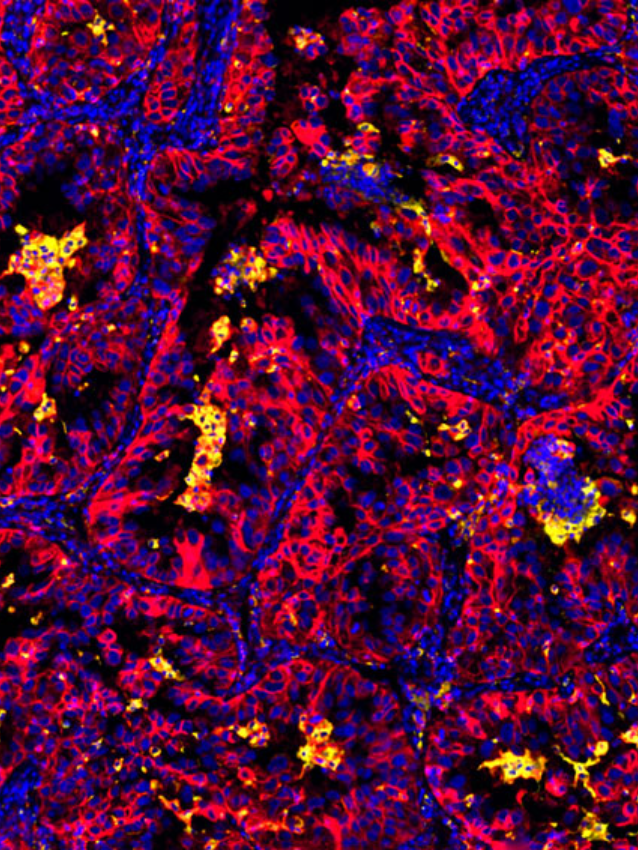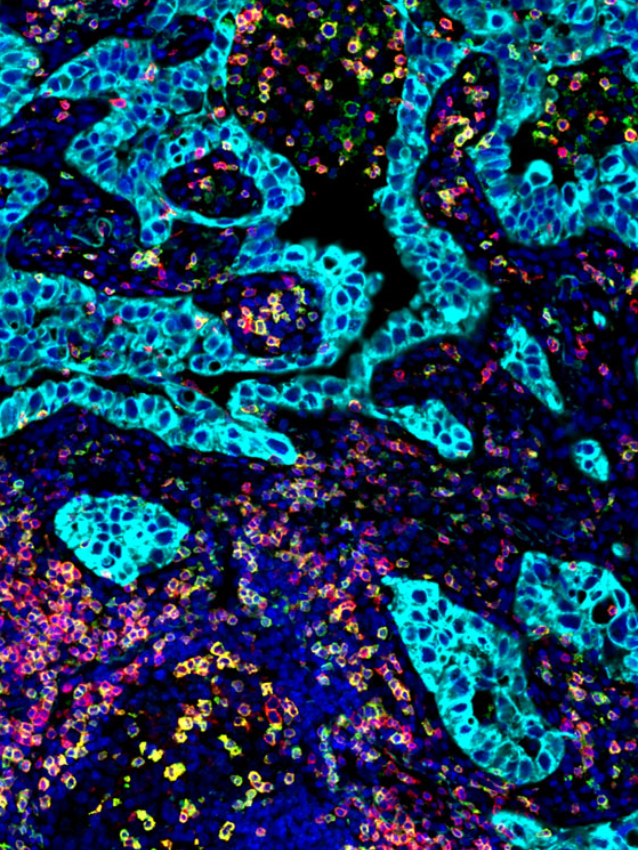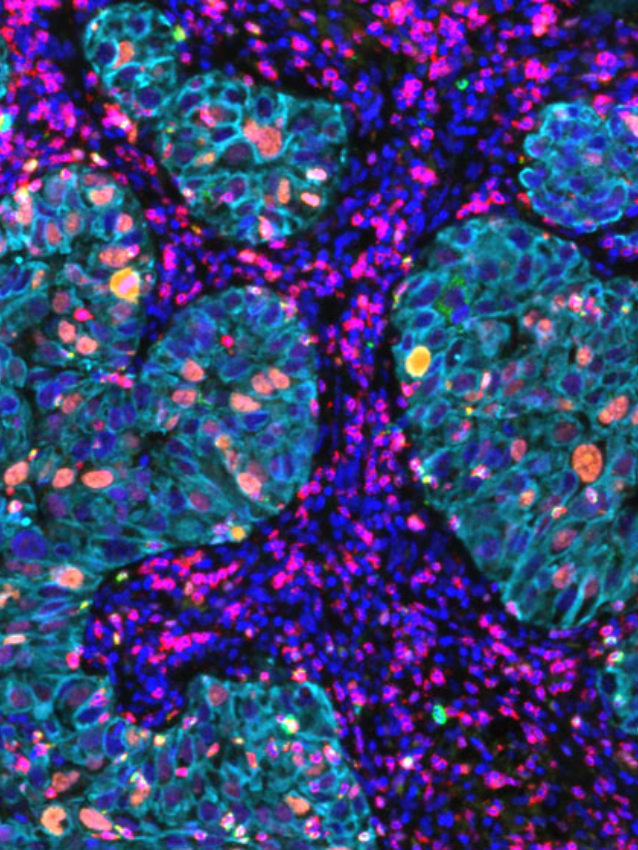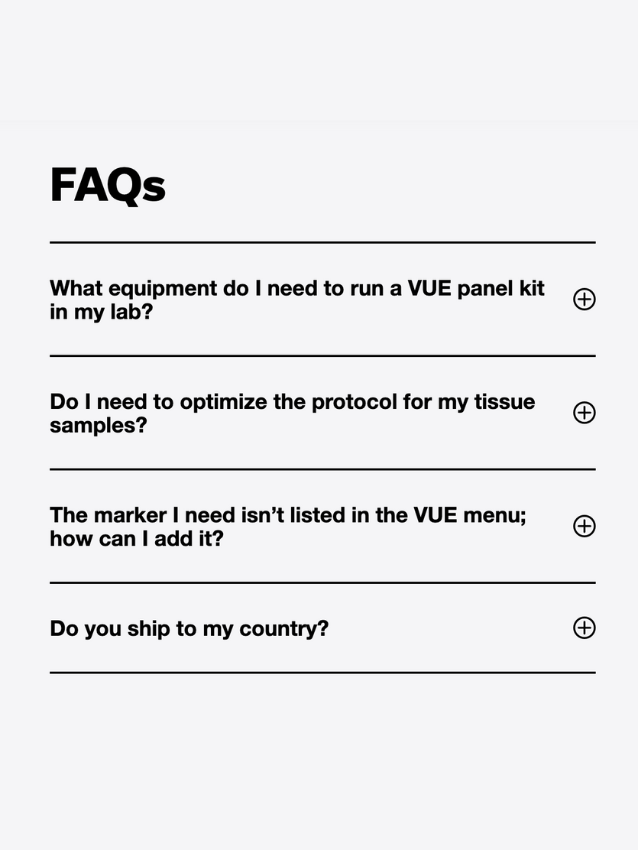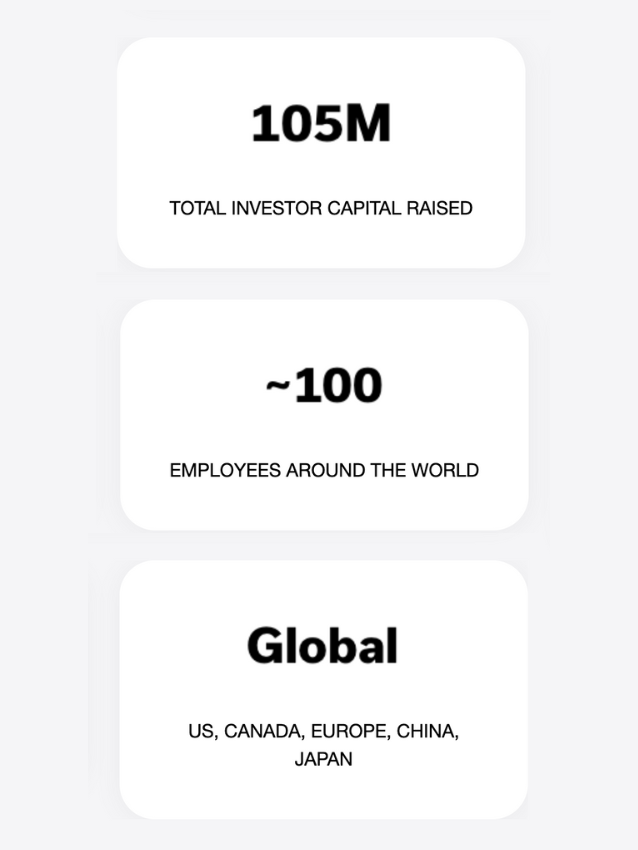Panel Configurator
What type of panel do you want?
Select FlexVUE to quickly get started with 8 plex exchangeable panels or go to Custom for customising your own 4 or 8 plex panel out of our 22 pre-optimized markers.
Create your custom panel
Guide: To create your panel, select 4 or 8 markers from our Custom Biomarker Menu. Choose the cellular and functional categories to see the available markers or search directly for the markers you need. Simply drag and drop the markers onto the custom panel configurator on the right. Descriptions of all markers are located below the two boxes. When you are satisfied with your panel, give it a name and click on Request Panel (minimum delivery size of 3 kits).
Results
My OmniVUE™ panel
Select up to 8 markers from the list from the left and drag and drop them here.
Explore our Core Biomarker Library
Marker descriptions
CD11b
CD11b is an integrin alpha M chain protein and is expressed by myeloid derived cells. It plays a key role in adherence of leukocytes to stimulate endothelium and mediates uptake of the complementcoated particles. Recent studies identify CD11b as a negative regulator of immune suppression and a target for cancer immune therapy. (Download Biomarker Datasheet)
CD11c
CD11c is one of four β2 integrins along with CD11a, CD11b and CD11d. CD11c, also known as integrin alpha X, is the most widely used defining marker for dendritic cells (DCs). It is a receptor for fibrinogen and functions in chemotaxis and cell adhesion. Integrins mediate myeloid cell recruitment from the blood vessels into tissue and lymph nodes and contribute to the immunological synapse between T cells and antigen presenting cells. (Download Biomarker Datasheet)
CD14
CD14 is a pattern recognition receptor that detects the pathogen-associate molecular patterns found on the surface of microorganisms. It is a co-receptor located on the cell surface that mediates the innate immune response. (Download Biomarker Datasheet)
CD15
CD15 is a cluster of cell surface glycoproteins and glycolipids, also known as 3-fucosyl-N-acetyl-lactosamine or Lewis X. CD15 is a carbohydrate adhesion molecule that functions in cell-to-cell recognition processes. It is a distinguishing marker for human myeloid cells and mediates neutrophil adhesion to dendritic cells. Several studies have shown that CD15 expression is associated with prognosis and survival in a variety of cancers, such as breast cancer and Hodgkin’s lymphoma. (Download Biomarker Datasheet)
CD163
CD163 is a type I transmembrane protein belonging to the group B of the scavenger receptor cysteine-rich superfamily. It is involved in the clearance and endocytosis of haptoglobin-hemoglobin complexes and has been widely used to identify M2 type macrophage. The scavenging role of CD163 is critical to its anti-inflammatory response, and recent findings have shown the significance of CD163-positive macrophages in tumor progression. (Download Biomarker Datasheet)
CD20
CD20 is a B cell differentiation antigen expressed in B cell development from early pre-B cell stage to mature B cell stage but lost on differentiation into plasma cells. Its role is in regulating B- cell activation, proliferation and differentiation. Aberrant CD20 expression has been described in mainly B cell tumor types such as Burkitt lymphoma, non-Hodgkin lymphoma, and chronic lymphocytic leukemia (CLL). (Download Biomarker Datasheet)
CD206
CD206 is a C-type lectin that can be found on certain populations of macrophages and dendritic cells. Also known as mannose receptor C type 1 (MRC1), it is normally expressed on M2 macrophages. CD206 is thought to play a role in innate and adaptive immunity by acting as a pattern recognition receptor for various pathogens. (Download Biomarker Datasheet)
CD3
CD3 is a multimeric protein composed of 4 subunits (γ, δ, ε, ζ), which are part of the T-cell receptor (TCR). Engagement of CD3 induces downstream signaling events that result in T-cell activation. The specificity of the CD3 antigen for T cells and its appearance at all stages of T cell development makes it an ideal T cell marker for both the detection of normal T cells and T cell neoplasms. (Download Biomarker Datasheet)
CD4
CD4 is a member of the immunoglobulin superfamily and is part of the TCR/CD3 complex, binding to MHC class II molecules and participating in signal transduction through recruitment of tyrosine kinase Lck. CD4 expression is used to identify helper T cells of which there are many different subsets including Th1, Th2, Th9, Th17, regulatory T cell, and follicular helper T cell. Each of these contributes to immune function through their unique cytokine profile. (Download Biomarker Datasheet)
CD45RO
CD45RO is expressed on activated and memory T cells, some B cell subsets, activated monocytes/macrophages, and granulocytes. Lack of CD45RO on T cells indicates naive T cell subsets while CD45RO expression indicated previous antigen exposure and defines the memory T cell subset. High density of CD45RO+ T cells in solid tumors is associated with a better prognosis. (Download Biomarker Datasheet)
CD56
CD56, also known as neural cell adhesion molecule (NCAM) is a transmembrane glycoprotein often considered a marker of neural lineage commitment due to its discovery site. CD56 expression is most strongly associated with natural killer (NK) cells but it has also been detected on other lymphoid cells, including gamma delta (γδ), T cells and activated CD8+ T cells, as well as dendritic cells. (Download Biomarker Datasheet)
CD68
CD68 is expressed on human macrophages and other mononuclear phagocytes. CD68 is a heavily glycosylated glycoprotein that is involved in ligand binding and is a member of the scavenger receptor family. CD68 functions in phagocytic activities and macrophage homing. An increased CD68+ macrophage index is associated with metastasis, shorter disease-free interval, poor prognosis, and reduced overall survival in multiple types of cancer. (Download Biomarker Datasheet)
CD8
CD8 is primarily expressed on cytotoxic T cells, but it can also be expressed on cortical thymocytes, dendritic cells and NK cells. CD8 is a transmembrane glycoprotein that is a co-receptor for the T cell receptor (TCR). CD8 binds MHC Class I to aid in antigen recognition and TCR-mediated activation. CD8 forms dimers of CD8ɑ and CD8β and clone C8/144B recognizes the alpha form of CD8. (Download Biomarker Datasheet)
CK
Cytokeratins play a cytoskeletal role in epithelial tissue and are an important component of intermediate filaments. These provide a structural framework for the cell and help resist mechanical stress. The mixture of AE1 and AE3 clones are able to detect a mixture of low and high molecular weight cytokeratins, thus identifying a broad range of cytokeratins. This marker can be used to identify the epithelial nature of tissue and tumors. (Download Biomarker Datasheet)
FoxP3
FoxP3, or Forkhead Box P3 is a transcription factor important in the development and inhibitory function of regulatory T cells (Tregs). FoxP3 functions by inhibiting cytokine production and T cell effector function, thus playing a crucial role in maintenance of immunological tolerance and control of immune responses against tumors and pathogens. (Download Biomarker Datasheet)
GrzB
Granzyme B (GrzB) is a serine protease stored in secretory granules of Cytotoxic T lymphocytes (CTLs) and Natural killer (NK) cells. Activated cytotoxic cells release granzyme B which enters the target cells where it can interact with cellular substrates to initiate cell death. (Download Biomarker Datasheet)
HLA-DR
Human leukocyte antigen (HLA) complex encodes the major histocompatibility complex (MHC). HLA-DR is the main isotype of 3 isotype (-DR, -DP, -DQ) responsible for presentation of antigens to T cells and B cells. Often, HLA-DR is used as a marker indicating the presence of antigen-presenting cells. HLA-DR expression in tumors has been shown to be positively associated with patient prognosis in some cancers such as colorectal cancer but is negatively associated with prognosis in other cancer types, such as glioma. (Download Biomarker Datasheet)
Ki67
Ki67 is a nuclear marker associated with cellular proliferation. Ki67 is present within the nucleus of cells undergoing division during interphase but is absent in quiescent cells. Ki67 can also be used as a prognostic indicator in certain cancers. (Download Biomarker Datasheet)
MHC II
Major Histocompability Complex II (MHC II) molecules are heterodimer complex that presents peptide antigen on the surface of the professional antigen presenting cells (APC’s) like macrophages and dendritic cells. Presentation of the antigen by MHC II complex is critical in CD4 activation and development of adaptive immune response. Along with APC’s, B cells and epithelial cells also present the MHC II molecule. (Download Biomarker Datasheet)
PD1
Programmed cell death protein 1, also known as PD1 and CD279, is an inhibitory receptor expressed by all T cells during activation. It regulates T cell effector functions during physiological responses, including acute and chronic infection, cancer, and autoimmunity. When PD-1 is bound to his ligand PD-L1, it prevents T cells from killing target cells including cancer cells. (Download Biomarker Datasheet)
PD-L1
Programmed cell death ligand 1 (PD-L1) is a type 1 transmembrane protein (B7-H1) that belongs to the B7 ligands family and may be expressed on both, hematopoietic cells (dendritic cells, macrophages, mast cells, T cells and B cells) and non-hematopoietic cells, including endothelial, epithelial and tumor cells. It plays an immunosuppressive role by inhibiting T-cell activity. Overexpression of PD-L1 by cancer cells may enable them to evade the host immune response, conferring a growth advantage to such tumors. (Download Biomarker Datasheet)
Sox10
Sox10 (Sry-related HMg-Box gene 10) is a nuclear transcription factor invovled in differentiation of neural crest progenator cells to melanocytes and maintanace of Schwann cells. Its high expression is observed in the melanocytic tumors of skin, soft tissue and primary as well as metastatic melanoma. (Download Biomarker Datasheet)
CK/Sox10
Cytokeratins play a cytoskeletal role in epithelial tissue and are an important component of intermediate filaments. These provide a structural framework for the cell and help resist mechanical stress. The mixture of AE1 and AE3clones can detect a mixture of low and high molecular weight cytokeratins, thus identifying a broad range of cytokeratins. This marker can be used to identify the epithelial nature of tissue and tumors. (Download Biomarker Datasheet)
SOX10 (Sry-related HMg-Box gene 10) is a nuclear transcription factor involved in differentiation of neural crest progenitor cells to melanocytes and maintenance of Schwann cells. Its high expression is observed in the melanocytic tumors of skin, soft tissue and primary as well as metastatic melanoma. (Download Biomarker Datasheet)
CTLA-4
CTLA-4 (Cytotoxic T-Lymphocyte Associated Protein 4) is an immune checkpoint receptor expressed on T cells. It plays a crucial role in downregulating immune responses. By binding to its ligands B7-1 (CD80) and B7-2 (CD86) on antigen-presenting cells, CTLA-4 outcompetes CD28, thereby delivering inhibitory signals to T cells. This mechanism is vital for maintaining immune homeostasis and preventing autoimmunity. Recent research has highlighted the importance of CTLA-4 in cancer immunotherapy, where its inhibition can enhance anti-tumor immune responses (Download Biomarker Datasheet).
CD68/CD163
CD68 is expressed on human macrophages and other mononuclear phagocytes. CD68 is a heavily glycosylated glycoprotein that is involved in ligand binding and is a member of the scavenger receptor family. CD68 functions in phagocytic activities and macrophage homing. An increased CD68+ macrophage index is associated with metastasis, shorter disease-free interval, poor prognosis, and reduced overall survival in multiple types of cancer. (Download Biomarker Datasheet)
CD163 is a type I transmembrane protein belonging to the group B of the scavenger receptor cysteine-rich superfamily. It is involved in the clearance and endocytosis of haptoglobin-hemoglobin complexes and has been widely used to identify M2 type macrophage. The scavenging role of CD163 is critical to its anti-inflammatory response, and recent findings have shown the significance of CD163-positive macrophages in tumor progression. (Download Biomarker Datasheet)
Lag3
Lag3 (Lymphocyte-Activation Gene 3) is an immune checkpoint receptor expressed on activated T cells, regulatory T cells (Tregs), natural killer (NK) cells, and dendritic cells. It functions as a negative regulator of immune responses, similar to CTLA-4 and PD-1. LAG3 binds to MHC class II molecules, inhibiting T cell proliferation and cytokine secretion. Its role in immune regulation makes it an important target in cancer immunotherapy, where blocking LAG3 can enhance anti-tumor immunity. LAG3 has also been implicated in autoimmune diseases and chronic infections (Download Biomarker Datasheet).
HER2
HER2 (Human Epidermal Growth Factor Receptor 2) is a transmembrane tyrosine kinase receptor belonging to the EGFR family, involved in the regulation of cell growth and differentiation. HER2 is overexpressed in certain cancers, most notably breast and gastric cancers, where it drives aggressive tumor cells proliferation, survival and tissue invasion. HER2 protein overexpression or ERBB2 gene amplification are key predictive biomarker in oncology, guiding therapeutic decisions such as the use of targeted therapies like trastuzumab, pertuzumab, and Antibody-Drug Conjugates (ADCs) like trastuzumab deruxtecan. ADCs targeting HER2 have revolutionized the treatment of HER2-positive cancers and have led to the recent approval of the first tumor-agnostic HER2-directed therapy for previously treated patients with metastatic HER2-positive solid tumors. (Download Biomarker Datasheet)
TROP2
TROP2 (Trophoblast cell surface antigen 2) is a transmembrane glycoprotein that plays a critical role in cell proliferation and signal transduction. It is highly expressed in most human cancers but hardly expresses in normal tissues, making it an ideal target for cancer therapy. TROP2 overexpression is associated with aggressive tumor behavior and poor prognosis, particularly in cancers such as breast, prostate, and colorectal cancer. Its role as a target in antibody-drug conjugate therapies is currently under active investigation (Download Biomarker Datasheet).
TF
Tissue Factor (TF) is a transmembrane protein that plays a critical role in the initiation of blood coagulation. It is expressed in various cells, including epithelial cells, macrophages, and tumor cells, where it acts as a receptor for Factor VII/VIIa, triggering the clotting cascade. Beyond its role in hemostasis, TF is involved in various pathophysiological processes such as cancer progression, metastasis, and inflammation. Due to its role in promoting tumor angiogenesis and metastasis, TF is a promising target in cancer therapies, including Antibody-Drug Conjugates (ADCs), which exploit TF’s overexpression in tumors for targeted delivery of cytotoxic drugs (Download Biomarker Datasheet).
FRα
Folate Receptor alpha (FRα) is a high-affinity cell surface protein involved in the transport of folate into cells. It is highly expressed in various epithelial cancers, including ovarian, lung, breast, and renal cancers, while being minimally expressed in most normal tissues. Folate Receptor’s restricted expression in normal cells and its overexpression in cancerous tissues make it an attractive target for cancer therapies, especially Antibody-Drug Conjugates (ADCs). By linking cytotoxic drugs to antibodies that specifically target Folate Receptor, ADCs exploit this overexpression for precise delivery of anticancer agents, limiting toxicity to healthy tissues. Folate Receptor also plays roles in mediating immune responses and in cellular growth and differentiation (Download Biomarker Datasheet).
Create your custom panel
Guide: To create your panel, select 4 or 8 markers from our Custom Biomarker Menu. Choose the cellular and functional categories to see the available markers or search directly for the markers you need. Simply drag and drop the markers onto the custom panel configurator on the right. Descriptions of all markers are located below the two boxes. When you are satisfied with your panel, give it a name and click on Request Panel (minimum delivery size of 3 kits).
Pre-optimized markers
Marker descriptionsSelect
Results
No markers have been exchanged yet
Explore our Core Biomarker Library
Marker descriptions
CD11b
CD11b is an integrin alpha M chain protein and is expressed by myeloid derived cells. It plays a key role in adherence of leukocytes to stimulate endothelium and mediates uptake of the complementcoated particles. Recent studies identify CD11b as a negative regulator of immune suppression and a target for cancer immune therapy. (Download Biomarker Datasheet)
CD11c
CD11c is one of four β2 integrins along with CD11a, CD11b and CD11d. CD11c, also known as integrin alpha X, is the most widely used defining marker for dendritic cells (DCs). It is a receptor for fibrinogen and functions in chemotaxis and cell adhesion. Integrins mediate myeloid cell recruitment from the blood vessels into tissue and lymph nodes and contribute to the immunological synapse between T cells and antigen presenting cells. (Download Biomarker Datasheet)
CD14
CD14 is a pattern recognition receptor that detects the pathogen-associate molecular patterns found on the surface of microorganisms. It is a co-receptor located on the cell surface that mediates the innate immune response. (Download Biomarker Datasheet)
CD15
CD15 is a cluster of cell surface glycoproteins and glycolipids, also known as 3-fucosyl-N-acetyl-lactosamine or Lewis X. CD15 is a carbohydrate adhesion molecule that functions in cell-to-cell recognition processes. It is a distinguishing marker for human myeloid cells and mediates neutrophil adhesion to dendritic cells. Several studies have shown that CD15 expression is associated with prognosis and survival in a variety of cancers, such as breast cancer and Hodgkin’s lymphoma. (Download Biomarker Datasheet)
CD163
CD163 is a type I transmembrane protein belonging to the group B of the scavenger receptor cysteine-rich superfamily. It is involved in the clearance and endocytosis of haptoglobin-hemoglobin complexes and has been widely used to identify M2 type macrophage. The scavenging role of CD163 is critical to its anti-inflammatory response, and recent findings have shown the significance of CD163-positive macrophages in tumor progression. (Download Biomarker Datasheet)
CD20
CD20 is a B cell differentiation antigen expressed in B cell development from early pre-B cell stage to mature B cell stage but lost on differentiation into plasma cells. Its role is in regulating B- cell activation, proliferation and differentiation. Aberrant CD20 expression has been described in mainly B cell tumor types such as Burkitt lymphoma, non-Hodgkin lymphoma, and chronic lymphocytic leukemia (CLL). (Download Biomarker Datasheet)
CD206
CD206 is a C-type lectin that can be found on certain populations of macrophages and dendritic cells. Also known as mannose receptor C type 1 (MRC1), it is normally expressed on M2 macrophages. CD206 is thought to play a role in innate and adaptive immunity by acting as a pattern recognition receptor for various pathogens. (Download Biomarker Datasheet)
CD3
CD3 is a multimeric protein composed of 4 subunits (γ, δ, ε, ζ), which are part of the T-cell receptor (TCR). Engagement of CD3 induces downstream signaling events that result in T-cell activation. The specificity of the CD3 antigen for T cells and its appearance at all stages of T cell development makes it an ideal T cell marker for both the detection of normal T cells and T cell neoplasms. (Download Biomarker Datasheet)
CD4
CD4 is a member of the immunoglobulin superfamily and is part of the TCR/CD3 complex, binding to MHC class II molecules and participating in signal transduction through recruitment of tyrosine kinase Lck. CD4 expression is used to identify helper T cells of which there are many different subsets including Th1, Th2, Th9, Th17, regulatory T cell, and follicular helper T cell. Each of these contributes to immune function through their unique cytokine profile. (Download Biomarker Datasheet)
CD45RO
CD45RO is expressed on activated and memory T cells, some B cell subsets, activated monocytes/macrophages, and granulocytes. Lack of CD45RO on T cells indicates naive T cell subsets while CD45RO expression indicated previous antigen exposure and defines the memory T cell subset. High density of CD45RO+ T cells in solid tumors is associated with a better prognosis. (Download Biomarker Datasheet)
CD56
CD56, also known as neural cell adhesion molecule (NCAM) is a transmembrane glycoprotein often considered a marker of neural lineage commitment due to its discovery site. CD56 expression is most strongly associated with natural killer (NK) cells but it has also been detected on other lymphoid cells, including gamma delta (γδ), T cells and activated CD8+ T cells, as well as dendritic cells. (Download Biomarker Datasheet)
CD68
CD68 is expressed on human macrophages and other mononuclear phagocytes. CD68 is a heavily glycosylated glycoprotein that is involved in ligand binding and is a member of the scavenger receptor family. CD68 functions in phagocytic activities and macrophage homing. An increased CD68+ macrophage index is associated with metastasis, shorter disease-free interval, poor prognosis, and reduced overall survival in multiple types of cancer. (Download Biomarker Datasheet)
CD8
CD8 is primarily expressed on cytotoxic T cells, but it can also be expressed on cortical thymocytes, dendritic cells and NK cells. CD8 is a transmembrane glycoprotein that is a co-receptor for the T cell receptor (TCR). CD8 binds MHC Class I to aid in antigen recognition and TCR-mediated activation. CD8 forms dimers of CD8ɑ and CD8β and clone C8/144B recognizes the alpha form of CD8. (Download Biomarker Datasheet)
CK
Cytokeratins play a cytoskeletal role in epithelial tissue and are an important component of intermediate filaments. These provide a structural framework for the cell and help resist mechanical stress. The mixture of AE1 and AE3 clones are able to detect a mixture of low and high molecular weight cytokeratins, thus identifying a broad range of cytokeratins. This marker can be used to identify the epithelial nature of tissue and tumors. (Download Biomarker Datasheet)
FoxP3
FoxP3, or Forkhead Box P3 is a transcription factor important in the development and inhibitory function of regulatory T cells (Tregs). FoxP3 functions by inhibiting cytokine production and T cell effector function, thus playing a crucial role in maintenance of immunological tolerance and control of immune responses against tumors and pathogens. (Download Biomarker Datasheet)
GrzB
Granzyme B (GrzB) is a serine protease stored in secretory granules of Cytotoxic T lymphocytes (CTLs) and Natural killer (NK) cells. Activated cytotoxic cells release granzyme B which enters the target cells where it can interact with cellular substrates to initiate cell death. (Download Biomarker Datasheet)
HLA-DR
Human leukocyte antigen (HLA) complex encodes the major histocompatibility complex (MHC). HLA-DR is the main isotype of 3 isotype (-DR, -DP, -DQ) responsible for presentation of antigens to T cells and B cells. Often, HLA-DR is used as a marker indicating the presence of antigen-presenting cells. HLA-DR expression in tumors has been shown to be positively associated with patient prognosis in some cancers such as colorectal cancer but is negatively associated with prognosis in other cancer types, such as glioma. (Download Biomarker Datasheet)
Ki67
Ki67 is a nuclear marker associated with cellular proliferation. Ki67 is present within the nucleus of cells undergoing division during interphase but is absent in quiescent cells. Ki67 can also be used as a prognostic indicator in certain cancers. (Download Biomarker Datasheet)
MHC II
Major Histocompability Complex II (MHC II) molecules are heterodimer complex that presents peptide antigen on the surface of the professional antigen presenting cells (APC’s) like macrophages and dendritic cells. Presentation of the antigen by MHC II complex is critical in CD4 activation and development of adaptive immune response. Along with APC’s, B cells and epithelial cells also present the MHC II molecule. (Download Biomarker Datasheet)
PD1
Programmed cell death protein 1, also known as PD1 and CD279, is an inhibitory receptor expressed by all T cells during activation. It regulates T cell effector functions during physiological responses, including acute and chronic infection, cancer, and autoimmunity. When PD-1 is bound to his ligand PD-L1, it prevents T cells from killing target cells including cancer cells. (Download Biomarker Datasheet)
PD-L1
Programmed cell death ligand 1 (PD-L1) is a type 1 transmembrane protein (B7-H1) that belongs to the B7 ligands family and may be expressed on both, hematopoietic cells (dendritic cells, macrophages, mast cells, T cells and B cells) and non-hematopoietic cells, including endothelial, epithelial and tumor cells. It plays an immunosuppressive role by inhibiting T-cell activity. Overexpression of PD-L1 by cancer cells may enable them to evade the host immune response, conferring a growth advantage to such tumors. (Download Biomarker Datasheet)
Sox10
Sox10 (Sry-related HMg-Box gene 10) is a nuclear transcription factor invovled in differentiation of neural crest progenator cells to melanocytes and maintanace of Schwann cells. Its high expression is observed in the melanocytic tumors of skin, soft tissue and primary as well as metastatic melanoma. (Download Biomarker Datasheet)
CK/Sox10
Cytokeratins play a cytoskeletal role in epithelial tissue and are an important component of intermediate filaments. These provide a structural framework for the cell and help resist mechanical stress. The mixture of AE1 and AE3clones can detect a mixture of low and high molecular weight cytokeratins, thus identifying a broad range of cytokeratins. This marker can be used to identify the epithelial nature of tissue and tumors. (Download Biomarker Datasheet)
SOX10 (Sry-related HMg-Box gene 10) is a nuclear transcription factor involved in differentiation of neural crest progenitor cells to melanocytes and maintenance of Schwann cells. Its high expression is observed in the melanocytic tumors of skin, soft tissue and primary as well as metastatic melanoma. (Download Biomarker Datasheet)
CTLA-4
CTLA-4 (Cytotoxic T-Lymphocyte Associated Protein 4) is an immune checkpoint receptor expressed on T cells. It plays a crucial role in downregulating immune responses. By binding to its ligands B7-1 (CD80) and B7-2 (CD86) on antigen-presenting cells, CTLA-4 outcompetes CD28, thereby delivering inhibitory signals to T cells. This mechanism is vital for maintaining immune homeostasis and preventing autoimmunity. Recent research has highlighted the importance of CTLA-4 in cancer immunotherapy, where its inhibition can enhance anti-tumor immune responses (Download Biomarker Datasheet).
CD68/CD163
CD68 is expressed on human macrophages and other mononuclear phagocytes. CD68 is a heavily glycosylated glycoprotein that is involved in ligand binding and is a member of the scavenger receptor family. CD68 functions in phagocytic activities and macrophage homing. An increased CD68+ macrophage index is associated with metastasis, shorter disease-free interval, poor prognosis, and reduced overall survival in multiple types of cancer. (Download Biomarker Datasheet)
CD163 is a type I transmembrane protein belonging to the group B of the scavenger receptor cysteine-rich superfamily. It is involved in the clearance and endocytosis of haptoglobin-hemoglobin complexes and has been widely used to identify M2 type macrophage. The scavenging role of CD163 is critical to its anti-inflammatory response, and recent findings have shown the significance of CD163-positive macrophages in tumor progression. (Download Biomarker Datasheet)
Lag3
Lag3 (Lymphocyte-Activation Gene 3) is an immune checkpoint receptor expressed on activated T cells, regulatory T cells (Tregs), natural killer (NK) cells, and dendritic cells. It functions as a negative regulator of immune responses, similar to CTLA-4 and PD-1. LAG3 binds to MHC class II molecules, inhibiting T cell proliferation and cytokine secretion. Its role in immune regulation makes it an important target in cancer immunotherapy, where blocking LAG3 can enhance anti-tumor immunity. LAG3 has also been implicated in autoimmune diseases and chronic infections (Download Biomarker Datasheet).
HER2
HER2 (Human Epidermal Growth Factor Receptor 2) is a transmembrane tyrosine kinase receptor belonging to the EGFR family, involved in the regulation of cell growth and differentiation. HER2 is overexpressed in certain cancers, most notably breast and gastric cancers, where it drives aggressive tumor cells proliferation, survival and tissue invasion. HER2 protein overexpression or ERBB2 gene amplification are key predictive biomarker in oncology, guiding therapeutic decisions such as the use of targeted therapies like trastuzumab, pertuzumab, and Antibody-Drug Conjugates (ADCs) like trastuzumab deruxtecan. ADCs targeting HER2 have revolutionized the treatment of HER2-positive cancers and have led to the recent approval of the first tumor-agnostic HER2-directed therapy for previously treated patients with metastatic HER2-positive solid tumors. (Download Biomarker Datasheet)
TROP2
TROP2 (Trophoblast cell surface antigen 2) is a transmembrane glycoprotein that plays a critical role in cell proliferation and signal transduction. It is highly expressed in most human cancers but hardly expresses in normal tissues, making it an ideal target for cancer therapy. TROP2 overexpression is associated with aggressive tumor behavior and poor prognosis, particularly in cancers such as breast, prostate, and colorectal cancer. Its role as a target in antibody-drug conjugate therapies is currently under active investigation (Download Biomarker Datasheet).
TF
Tissue Factor (TF) is a transmembrane protein that plays a critical role in the initiation of blood coagulation. It is expressed in various cells, including epithelial cells, macrophages, and tumor cells, where it acts as a receptor for Factor VII/VIIa, triggering the clotting cascade. Beyond its role in hemostasis, TF is involved in various pathophysiological processes such as cancer progression, metastasis, and inflammation. Due to its role in promoting tumor angiogenesis and metastasis, TF is a promising target in cancer therapies, including Antibody-Drug Conjugates (ADCs), which exploit TF’s overexpression in tumors for targeted delivery of cytotoxic drugs (Download Biomarker Datasheet).
FRα
Folate Receptor alpha (FRα) is a high-affinity cell surface protein involved in the transport of folate into cells. It is highly expressed in various epithelial cancers, including ovarian, lung, breast, and renal cancers, while being minimally expressed in most normal tissues. Folate Receptor’s restricted expression in normal cells and its overexpression in cancerous tissues make it an attractive target for cancer therapies, especially Antibody-Drug Conjugates (ADCs). By linking cytotoxic drugs to antibodies that specifically target Folate Receptor, ADCs exploit this overexpression for precise delivery of anticancer agents, limiting toxicity to healthy tissues. Folate Receptor also plays roles in mediating immune responses and in cellular growth and differentiation (Download Biomarker Datasheet).
Pre-defined FixVUE panels
Choose the pre-configured panel that best suits your research needs. Designed to assess the significant cell markers in the tissue microenvironment, these robust 4 and 8 plex panels are ready to use across multiple indications.
Prices are available from your local representative. Submit your configuration to learn more.
Immuno8 FixVUE Panel
Characterize T-cell subsets, immunosuppressive cells and interactions along the PD-L1/PD-1 checkpoint axis with this comprehensive immuno-oncology focused panel.
More detailsPD-L1 FixVUE Panel
Determine whether the tumor is “hot” or “cold”. Co-localize macrophages, cytotoxic T cells, tumor cells, and the underlying inhibitory or inflammatory mechanisms at play along the PD-L1 axis.
More detailsT-reg FixVUE Panel
Identify regulatory T cells and cytotoxic T cells within the tumor context. Characterize the different T cells that regulate immune response.
More detailsMDSC FixVUE Panel
Identify Myeloid Derived Suppressor Cells within the tumor microenvironment. Characterize cell populations into M-MDSCs and PMN-MDSCs.
More detailsPD-1 FixVUE panel
Determine whether the immune response has exhausted. Co-localize T cells, memory T cells, tumor cells, and the underlying PD-1 checkpoint immune exhaustion mechanism at play.
More detailsT-act FixVUE Panel
Determine whether T cells have the potential to mediate cell death. Examine the co-expression of proliferating cells, cytotoxic cells, tumor cells, and the underlying proliferative index and potential for T cell mediated death.
More detailsAPC FixVUE Panel
Identify and characterize professional antigen-presenting cells (APCs). Examine the co-expression and visualization of specific subsets of cells along the dendritic, monocyte/macrophage, and B cell lineages.
More details
Not sure which panel you need?
Talk to an expertFAQs
All FixVUE and FlexVUE kits are delivered as a complete set of reagents to perform multiplex staining on up to 10 tissue slides per kit. In addition to the typical lab equipment needed to process tissue slides, InSituPlex assays have been optimized for use with the Leica Biosystems BOND RX automated stainer, or via a manual protocol when this autostainer is not available.
In addition, the use of UltiStacker software is recommended to perform same slide image fusion of both multiplex immunofluorescent (mIF) images and H&E images. Once co-registered with this software, the images are ready for use with image analysis software. UltiStacker is available upon request with any FixVUE or FlexVUE order.
For the complete list of requirements, please contact us and we would be happy to set up a consultation with you.
Multiplex assays using InSituPlex technology have been pre-optimized for use across indications, allowing you to eliminate time consuming optimization steps. The FixVUE and FlexVUE kits are ready to use out of the box, simply follow the included protocol to achieve unprecedented resolution across your entire tissue sample.
In addition to FlexVUE and FixVUE marker panels, we offer an extensive list of pre-optimized markers in our Custom Biomarker Menu. This fully customizable biomarker menu allows you to build the unique panel to fit your research needs. In addition, our experts are on hand to help you design, build and execute your assays either directly in your lab or through our CLIA certified services lab.
Currently, ordering through our webshop is only available for organizations in the following countries: Austria, Belgium, Canada, Czech Republic, Denmark, Finland, France, Germany, Greece, Hungary, Ireland, Italy, Luxembourg, Netherlands, Norway, Poland, Portugal, Slovakia, Spain, Sweden, Switzerland, Turkey, United Kingdom, and the United States.
If you are not located in these countries, please contact us to find out what shipping options may be available to you through our network of distributors.

Welcome back
You don't have an account?

Welcome back
You don't have an account?
Headquarters US
763D Concord Avenue
Cambridge, MA 02138-1044, USA
+1 877-858-4883
contact@ultivue.com
Welcome Back
|
Introducing: Fully Configurable OmniVUE™ ADC Panels |
